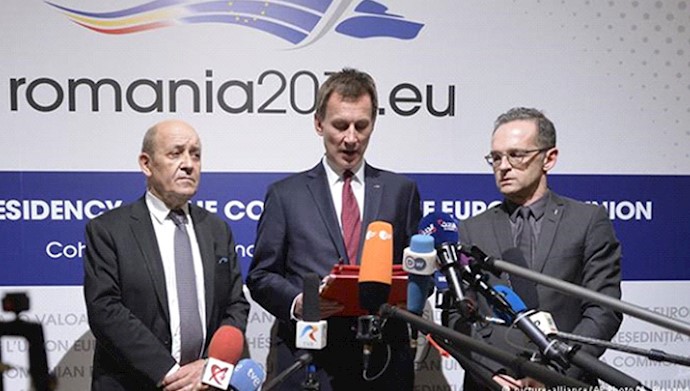Analysis by PMOI/MEK
Feb. 4, 2019 – The announcement on Jan 31, 2019, of establishing EU’s payment channel with Iran did not receive nearly as much attention as some of its defenders would have liked. Understanding the reason for this contributes to a more profound understanding of the stifling crises engulfing the Iranian regime. According to some analysts, you cannot cure a serious case of cancer by a quarter-pill of Aspirin.
Background
The creation of INSTEX, the latest in special purpose vehicle efforts aimed at facilitating trade between EU countries and the Iranian regime, has a history, which clarifies the reasons behind failure of such attempts.
Following the May 2018 announcement of the United States’ withdrawal from the 2015 Iran nuclear deal and of the re-imposition of sanctions, the EU stated that it was committed to its trade and economic relations with Tehran and announced the creation of a special purpose vehicle (SPV), to facilitate financial transactions with Iran.
EU set and missed so many deadlines on the SPV that very few, even within the Iranian regime, take new initiatives seriously. Apparently, the “vehicle” is moving far slower than it was promised to. According to the European Parliamentary Research Service (EPRS) “The EU High Representative initially stated on 25 September 2018 that the SPV could be established before November 2018.”
Then on November 2, the EU High Representative said that important details, such as the SPV’s location and participants, were still to be decided.
On December 10, 2018, when questioned about progress on the SPV, Federica Mogherini told reporters:
“I would expect this instrument to be established in the coming weeks so before the end of the year.” (Reuters Dec. 10, 2018)
Her deadline turned out to be wrong again, unless as a satirist put it, she meant the end some other year, for instance the Iranian year (March 20.)
Instex, in the real world
They finally announced that it was up and running—but not quite. For the following reasons:
- Trade will focus on nonsanctionable essential goods. “It is not expected to address oil-related transactions, Iran’s primary source of foreign currency.” (DW January 31, 2019)
What is the point then? Acquiring nonsanctioned goods has never been a problem. It is like building a bridge where there is no river. - The regime’s real problems with sanctions are not addressed at all. Oil exports have dropped from 2.5 million bpd to less than 1 million bpd.
Greece and Italy, who collectively purchased 600,000 bpd of oil before the sanctions, have ceased to do so. No oil tanker, no credible insurance company, and no bank even in Europe is cooperating with the regime in fear of heavy fines and penalties. The European Investment Bank has been clear on this all along. On July 18, 2018, Reuters reported that authorities of the European Investment Bank (EIB) had said they would risk their business model if they invested in Iran, because of U.S. sanctions. - The E3 countries (France, Germany, UK) set forth very difficult conditions for the regime to comply. They wrote in their joint statement, “INSTEX will function under the highest international standards with regards to antimoney laundering, combating the financing of terrorism (AML/CFT) and EU and UN sanctions compliance. In this respect, the E3 expect Iran to swiftly implement all elements of its FATF action plan.” The regime has a spectrum of difficulties in all levels complying with these conditions.
- Instex is an intermediary mechanism. No money is going to be transferred to Iran. Some critics say therefore, “It is not a financial channel, it is an accounting company.”
- The European powers have not yet established its budget. Nor have they defined its rules. (Reuters January 31, 2019)
- The U.S. has vowed to use all its leverage against it.
- Medium and small-size companies are more likely to follow larger companies who have already left Iran to avoid U.S. punishment.
- The Iranian regime has yet to build a compatible structure to work with this vehicle. The regime’s officials do not seem to be that enthusiastic. EU’s vehicle does not seem too promising for the regime. Kamal Kharrazi, head of the regime’s Strategic Council on Foreign Relations (ISCFR), who is also a senior adviser to Iranian supreme leader Ali Khamenei, expressed this reluctance when he said on Dec 19, 2018:
“We should not rely on these vehicles. We should plan for solutions to face economic problems and sanctions, inside the country. The government is doing its best in this direction.”
Perspectives
As the Brussels Times put it: “Some analysts are skeptical that such a mechanism will work. European companies can still be sanctioned for trading with Iran and many of them have already decided not take any risks.”
A European diplomat told Reuters “It won’t change things dramatically” and called Instex a political message.
The French Foreign Minister Jean-Yves Le Drian echoed with almost identical words: “It is a political act.” This statement was made after a meeting of EU counterparts in Bucharest which was supposed to lay down the practical steps for going forward.
So far, the only verifiable facts are the registration of Instex in France with a meager investment of only 3,000 euros, the decision that it will be headed by German banker Per Fischer, and that the three European powers hope other states will join later, although a senior German official said this was not imminent.
It does not look too promising for defeating the sanctions, does it?





